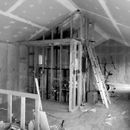ERV for Studio Apartment
Hello all,
Trying to finalize decision on mechanical ventilation for ~600 SF 2d story apartment in the detached accessory dwelling unit I’m completing (North Idaho, Zone 5).
Originally, I planned an exhaust-only system, using a Panasonic WhisperGreen fan located in the bathroom, with motion sensor and timer.
Based on the results of initial blower door testing, I expect the living spaces in the building , which also includes 300 SF office + bathroom on the first floor, to come in at 1 ACH50 or less. That has me thinking exhaust-only may not be an effective solution, at least not for the apartment. Looking at balanced systems, I’m considering a Panasonic WhisperComfort ERV with Panasonic’s FV-WC04VE1 Wall Cap with Styrofoam adaptor so I can use a single wall penetration for both intake and exhaust. Or, something like the Panasonic Select Cycler paired with WhisperGreen Bath fan https://www.greenbuildingadvisor.com/article/pros-and-cons-of-three-types-of-ventilation-systems
Questions: If I go with the ERV, will I still need separate bath fans? At 0.8 Sone and 40 cfm, it seems the ERV is louder and moves less air than the WhisperGreen bath fan, and is designed for continuous operation. Is the energy savings from the ERV worth it vs. a bath fan plus Select Cycler? (For reference, the ADU is heated with 2-1000 watt baseboard heaters controlled by programable thermostats, and designed for net zero or better, with PV to be installed this fall or next spring).
I’ve attached floor plans below which should things a bit more clear, as well as photos looking east and west of the second floor apartment interior, showing framed-in bathroom with mechanical space above.
Thanks in advance for any advice.
—David
GBA Detail Library
A collection of one thousand construction details organized by climate and house part











Replies
You should be fine with just the ERV: https://na.panasonic.com/ca/home-building-solutions/ventilation-indoor-air-quality/energy-recovery-ventilators-erv/intelli-balancetm-100-50-100-cfm
I would not use the FV-04VE1 as it spends way too much time in exhaust mode when temps get to the 20F area.
Pull air from the bathroom and kitchen areas (or sleeping areas if you want to make Martin happy :-) That ERV has a boost function so adding a switch in the bath should do the trick. The area above that bath is a great spot for installation...no drain required.
I'd separate the intake and exhaust by at least 9-10 feet if you can (as per their spec)...not a fan of the foam wall splitter/wall setup which is more designed for much lower airflow.
I've use the Panasonic spot ERV. It is great unit for the price point for smaller spaces. Efficiency is pretty bad but still WAY higher than the exhaust only option.
The tandem Panasonic cap is only really meant for the smaller spot ERV unit, it is way too restrictive for the IB100. You can use the one from a Lifebreath though. Similar idea as it only needs one hole and since it is larger it is much less restrictive. Simpler install, less flashing and one fewer hole through your envelope.
Deleted
You’re on the right track with the ERV for balanced ventilation, especially if you’re aiming for net-zero with PV soon. While the ERV does offer energy savings, it might not move enough air for bathroom humidity. Adding a separate WhisperGreen fan could help with quick moisture control, giving you targeted airflow when needed. This setup—common in energy-efficient apartments for sale—balances comfort and air quality effectively.
Hi dennwood and Akos,
Thanks for the replies. It seems the IntelliBalance 100 is going to be the way to go. From the specs, it looks like it will easily provide ventilation for both the upstairs apartment and the downstairs office, plus both bathrooms using the boost function. Prices I'm seeing for the Intellibalance are about $990, roughly double the spot ERV (FV-04VE1). But since I'd need two of the spot ERVs, that's pretty much a wash. Non-ERV ventilation, using something like (2) WhisperGreen bath fans + timers + passive intakes would be roughly $500, so ERV is ~$500 cost premium, vs. non-ERV.
The next question goes to ROI on ERV vs. non-ERV/HRV ventilation.
Akos, I looked at your calculations on this thread:
https://www.greenbuildingadvisor.com/question/thermodynamics-of-erv-hrv-preheat
So, using HDD for my area (6800) as the deltaT, I get: 6800 °F * 32.4 CFM * 1.08 = 238,000 BTU ( 69,700 W), or about 1670 kWh heat lost per year w/o an ERV. I'm ignoring CDD for the moment (no immediate plans to have mechanical cooling), and realize HDD may not be the best way to figure delta T.
I pay about $0.09/kWh, so that's ~$150 for heat lost w/0 ERV. If the IntelliBalance recovers 80% on average, it should save about $120/yr, or roughly 4 years before simple payback of $500 cost premium vs. non-ERV.
That seems reasonable, especially if an ERV increases comfort (e.g., warmer fresh air entering during cold months vs. non-ERV ventilation).
Do these figures seem in the ballpark? Have I completely missed something? The CFM figure I'm using is based on the formula 7.5 cfm/person + 1 cfm/100 SF.
Finally, is there any significant performance loss (or increase in noise) using 4" duct for the IntelliBalance vs. 6"? Obviously, the smaller duct will be easier to chase between floors.
Thanks again.
You are missing a 24h factor in your calculations.
The heat loss would be:
6800 °F *24h* 32.4 CFM * 1.08 = 57Therm or 1670kWh. Hmm.... Somehow your kWh is correct.
Either way, exhaust only ventilation when you heat with resistance strip is pretty expensive. The ROI on energy recovery in cold climate if it can be done for reasonable cost is pretty quick. The IB100 is a fantastic unit in terms of performance and cost, can't go wrong with it.
I would run 5" or 6" ducts for the main trunk of the ERV. If you are using the Lifebreath dual vent, run 5" for the outside connections and 6" for the inside ducting. This would be much lower velocity at boost and lower noise. The 4" can be made to work but it will be louder plus since it is more restrictive, it will consume more blower power.
Once you start branching off, the ducting can be reduced to make it easier to fish. It might also be worth while to bump up the thickness of interior wall where the ducts go so you can simply run 4" flex for most connections. The only thing that should be larger is the kitchen stale air pickup which should be 5".
Yeah--I multiplied 69,700 W by 24 h in the next step--forgot to show the work :).
I'm going with resistance heat because modeling showed energy use with resistance was low enough the energy savings from a mini-split HP didn't justify the additional cost (even installing the HP myself). Since the plan is to be net zero with PV installed in less than a year, and since baseboards and thermostats for the apartment are less than $200 total, there didn't seem to be a reason not to do the experiment. If I need to add a mini-split in a year or two (to deal with cooling load during wildfire season for example, when smoke prevents night-flush cooling), I'm really not out anything.
Seems like the IB100 is basically a no-brainer in terms of ROI. It'll take a little head-scratching to figure out where to run a 6" trunk. The wet wall's pretty packed, and there's not much space to add even a couple inches to other walls.
Kitchen, on the other hand, has its own exhaust hood. Does that mean a kitchen stale air pickup is still necessary?
Akos can crunch your numbers there but I figure ROI is less important than the big picture IMHO :-)
I have the spot ERV in use and although it is cheap the delta T at cold temps is not great. This is live data in fact from one in my house...efficiency is crap:
https://www.hundredgraphs.com/public/denwood
So ya, 100% go with the real deal.
You have lots of room there for acoustic duct lining or duct mufflers (highly recommended and easy to build if noise is an issue). I've done a lot of work with sound attenuation and HVAC and a few bucks spent on duct mufflers and/or acoustic duct lining (if you the the room for it) makes a massive difference in sound with very little effort. If you have stud cavities available inside, you can also use larger rectangular duct, but you also have ECM motors on that ERV with 100 CFM rating. Getting to 30-40 CFM in a few 4" ducts should be just fine if you stick with hard duct.